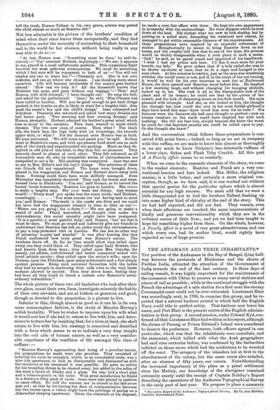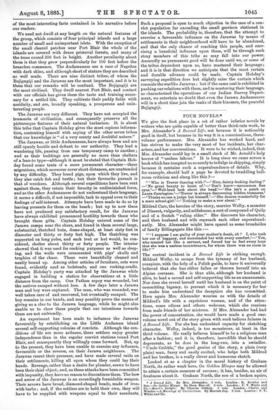THE ANDAMANS AND THEIR INHABITANTS.* TEE position of the Andamans
in the Bay of Bengal, lying half- way between the peninsula of Hindostau and the shores of Further India, attracted the attention of the Government of India towards the end of the last century. In those days of sailing vessels, it was highly important for the maintenance of the commerce with China to possess as many naval stations and places of call as possible ; while in the continual struggle with the French the advantage of a safe station for a fleet near the stormy Coromandel coast could not be over-estimated. Lieutenant Blair was accordingly sent, in 1788, to examine this group, and he re- ported that a natural harbour existed in which half the English Navy could ride in perfect safety. That harbour now bears his name, and Port Blair is the present centre of the English adminis- tration in that group. A second mission, under Colonel Kyd, con- firmed all that Lieutenant Blair had written in his report, although the claims of Penang or Prince Edward's Island were considered to deserve the preference. However, both officers agreed in one particular, which was that the inhabitants were cannibals, and the statement, which tallied with what the Arab geographers had said nine centuries before, was confirmed by the barbarities inflicted on those crews which bad the misfortune to be wrecked off the coast. The savagery of the islanders led at first to the abandonment of the colony, but the same cause also entailed, after an absence of fifty years, our return. Notwithstanding the increased importance of the place as a penal settlement since the Mutiny, our knowledge of the aborigines remained extremely scanty until the receipt of Captain Hobday's Report describing the operations of the Andaman Topographical Survey in the early part of last year We propose to place a summary
• Narrative Report of the Andaman Topographical Survey. By Ca. tain Hobday. Calcutta Government Press.
of the most interesting facts contained in his narrative before our readers.
We need not dwell at any length on the natural features of the group, which consists of four principal islands and a large number of small and unimportant islets. With the exception of the small cleared patches near Port Blair the whole of the islands are covered with dense primeval forests, and many of the trees exceed 200 feet in height. Another peculiarity about them is that they grow perpendicularly for 100 feet before the branches commence. The Andamanese are a race of Negritos with dark skins, and although short of stature they are described as well made. There are nine distinct tribes, of whom the Bojigngiji and the Jarawas are the most important, and it is to them that our remarks will be confined. The Bojigngiji are the most civilised. They dwell nearest Port Blair, and contact with our officials has given them the taste and training neces- sary for a settled life. They cultivate their paddy fields with assiduity, and are, broadly speaking, a prosperous and unin- teresting people.
The Jarawas are very different. They have not accepted the trammels of civilisation, and consequently preserve all the picturesque features of their natural barbarism. It is about this tribe that Captain Hobday gives the most copious informa- tion, contenting himself with saying of the other seven tribes that our knowledge is "of a very scanty and doubtful nature."
The Jarawas, or little Andamanese, have always been and are still openly hostile and defiant to our authority. They lead a wandering life, passing from one temporary camp to another ; and as their buildings are generally no more than shelters of a lean-to type—although it must be stated that Captain Hob- day found some tents of a more permanent character—these migrations, which moreover cover short distances, are unattended by any difficulty. They breed pigs, upon which they live, and they also catch fish and turtle ; but their favourite pursuit is that of wreckers. Although several expeditions have been sent against them, they retain their ferocity in undiminished force, and as the other Andamanese do not understand their language, -it seems a difficult, if not impossible, task to appeal even to their feelings of self-interest. Attempts have been made to do so by leaving presents for them on the beach ; but up to now these have not produced any satisfactory result, for the Jarawas have always exhibited pronounced hostility towards those who brought these gifts. Captain Hobday entered some of the Jarawa camps near the shore, and found in them several large, substantial, thatched huts, dome-shaped, at least sixty feet in diameter and thirty or forty feet high. The thatching was -supported on long poles, and each tent or hut would, he con- sidered, shelter about thirty or forty people. The interior showed that it was used for cooking purposes as well as sleep- ing, and the walls were ornamented with pigs' skulls and trophies of the chase. These were beautifully cleaned and neatly bound up. Among other articles of furniture, cots were found, evidently used as bedsteads, and one rocking-cradle. Captain Hobday's party was attacked by the Jarawas while engaged in building a station for observations at a little distance from the camp. One Pathan sepoy was wounded, but the natives escaped without loss. A few days later a Jarawa man and boy were captured. The man, who was wounded, was well taken care of and recovered, but eventually escaped. The boy remains in our bands, and may possibly prove the means of giving us a clue to the Jarawa language, while be might also enable us to show these people that our intentions towards them are not unfriendly.
An experiment has been made to influence the Jarawas favourably by establishing on the Little Andaman island several self-supporting colonies of convicts. Although the con- ditions of life are more arduous, these settlers enjoy greater independence than in the regular convict stations round Port Blair, and consequently they willingly come forward. But, up to the present, they have been unable to exercise any influence, favourable or the reverse, on their Jarawa neighbours. The Jarawas resent their presence, and have made several raids on their settlements, killing all upon whom they could lay their hands. Revenge, rather than a desire for plunder, seems to have been their chief object; and, as these attacks have been committed with impunity, they have no reason to discontinue them. The bow and arrow of the Jarawas is an exceedingly formidable weapon Their arrows have broad, diamond-shaped heads, made of iron, with barbs ; and, if the settlers are to hold their own, they will have to be supplied with weapons equal to their assailants. Such a proposal is open to much objection in the case of a con- vict population far exceeding the small garrison stationed in the islands. The probability is, therefore, that the attempt to exercise a favourable influence on the Jarawas by means of settlements in their neighbourhood will have to be abandoned, and that the only chance of reaching this people, and exer- cising a beneficial influence upon them, will be through such stray members of this tribe as may fall into our power. Assuredly no permanent good will be done until we, or some of the tribes dependent upon us, have mastered their language; and it is in that direction we anticipate that the most certain and durable advance could be made. Captain Hobday's surveying expedition does but slightly raise the curtain which conceals the warlike Jarawas ; but if the same zeal is exhibited in pushing our relations with them, and in mastering their language, as characterised the operations of our Indian Survey Depart- ment, we entertain no doubt that even the Jarawa Andamanese will in a short time join the ranks of their kinsmen, the peaceful Bojigngiji.



































 Previous page
Previous page